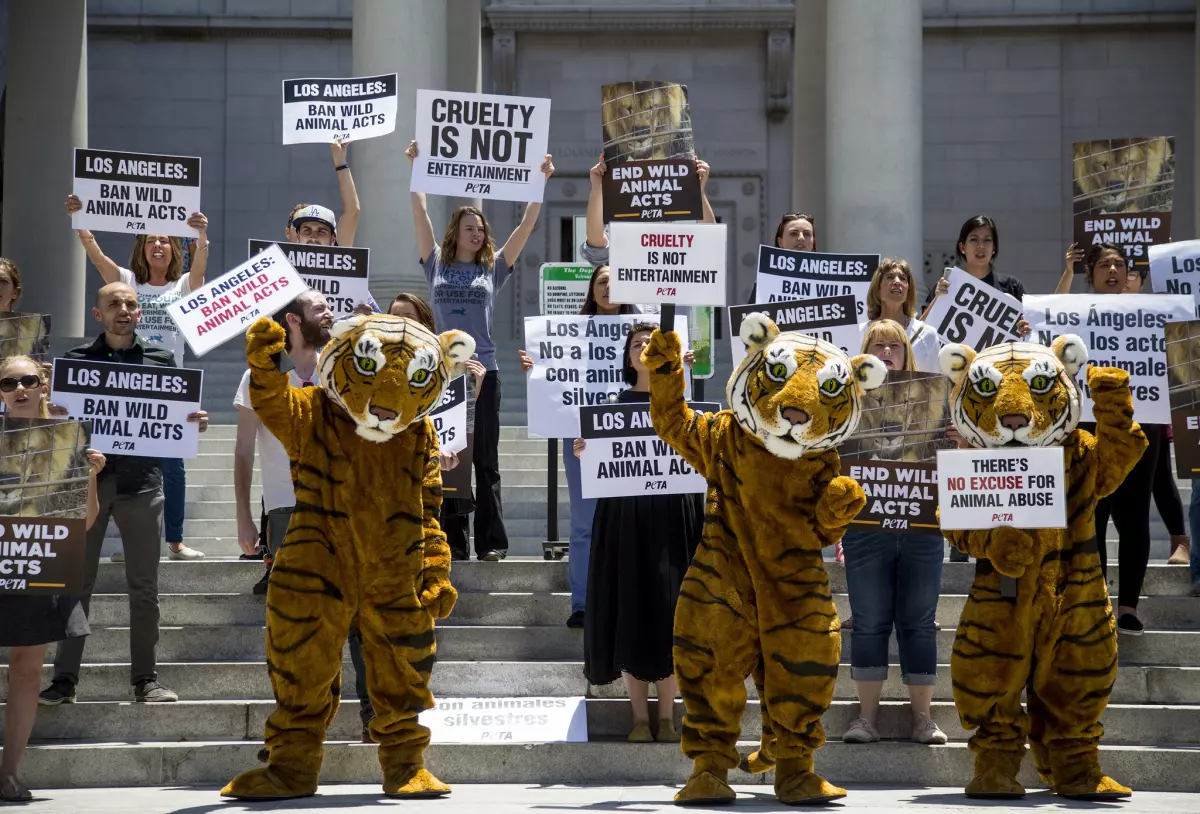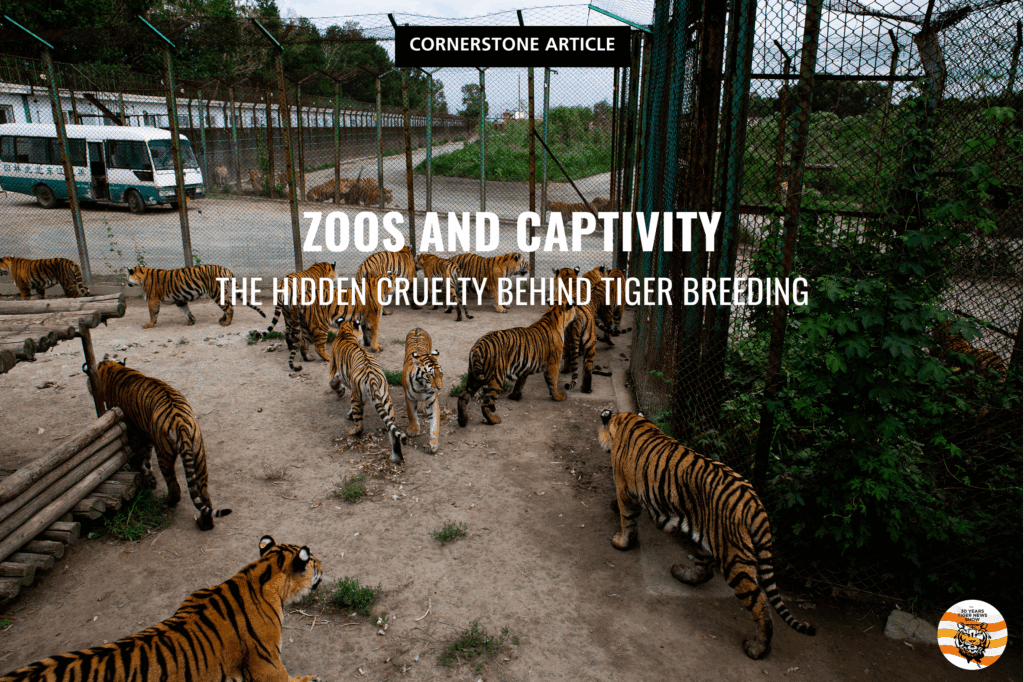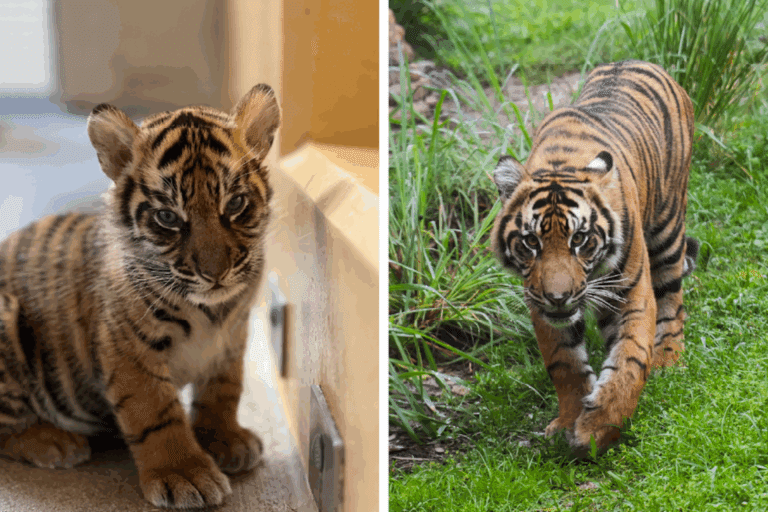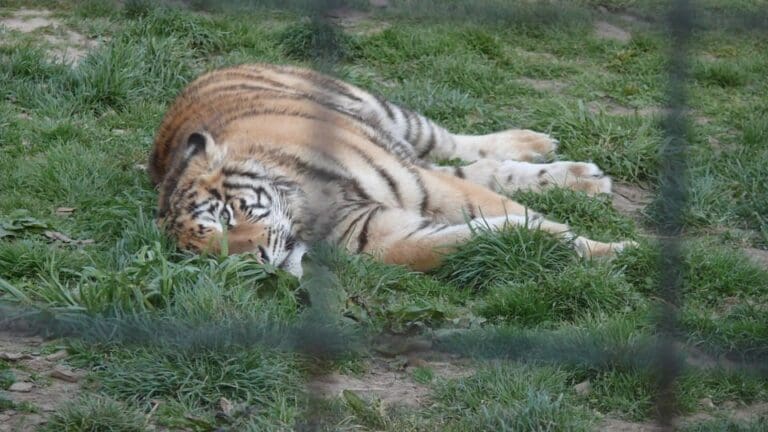Introduction: The Illusion of Tiger Captivity
Tiger captivity is sold as conservation. Zoos promote themselves as guardians of wildlife, boasting about education programs, breeding projects, and “saving species for the future.” Their brochures are full of lush photographs, mascots, and staged school visits. But behind the polished marketing and carefully orchestrated family days, tiger captivity is built on exploitation. These institutions are not conservation centers; they are entertainment businesses with cages at their core.
Tigers are the ultimate moneymakers of captivity. They are the faces on billboards, the stars of zoo websites, and the reason ticket prices keep climbing. Every time a cub is born, press releases gush about “hope for the species.” Local TV crews are invited. Visitors line up to see the newborns. But the reality is brutal: that cub will never be released into the wild, never live the life of a real tiger, and never contribute to saving its species. It was bred for ticket sales, selfies, and profit.
In truth, tiger captivity is an ancient artifact of human greed — an institution that has not evolved, only rebranded itself to suit modern marketing. The billions poured into cages could restore habitats, fund patrols, and double protection efforts. Instead, it feeds a global machine of concrete walls, fences, and endless breeding cycles designed not to save, but to sell.
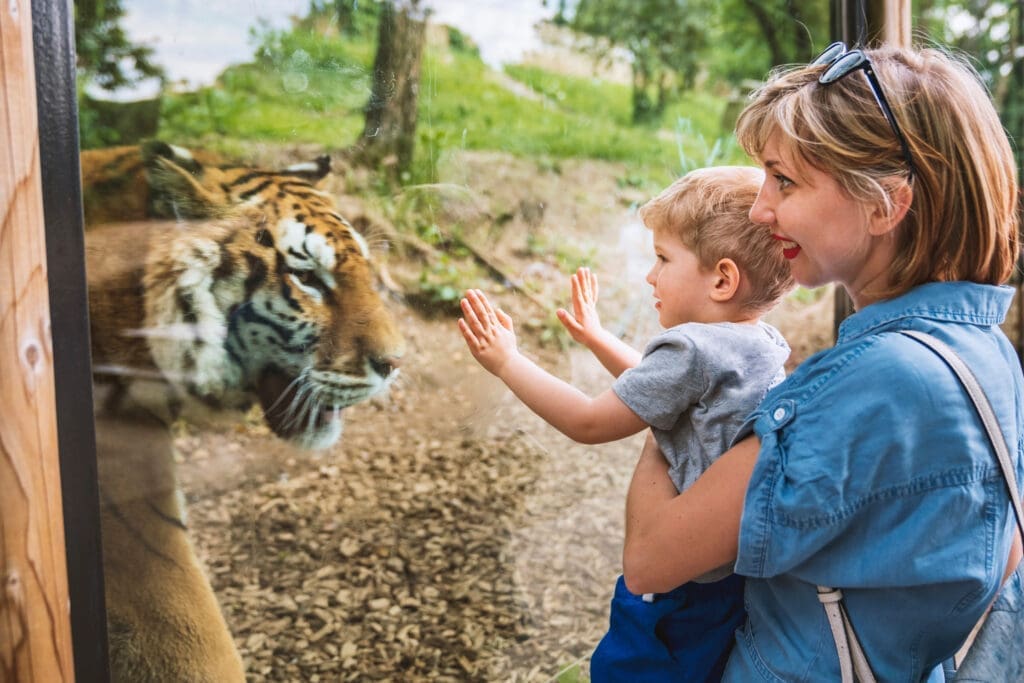
Ancient Roots: A History of Tiger Captivity
The story of tiger captivity is as old as human empire itself. The Romans perfected it as spectacle. Their arenas overflowed with stolen animals — lions, leopards, elephants, and tigers dragged from Asia and Africa to die for sport. Ancient texts describe how ships arrived in Mediterranean ports filled with cages, unloading beasts that would be slaughtered before roaring crowds. Even the very name “tigris” was taken from Mesopotamia, where the Tigris River flowed through the region from which many of these striped animals were stolen. To the Romans, the tiger was not a living being but a symbol of conquest, reduced to blood and sand.
The Greeks too played their part. Kings and philosophers displayed animals in menageries, treating them as curiosities and trophies. In their view, possessing the rarest creatures proved dominance over nature itself. The practice carried forward into medieval Europe, where monarchs kept private collections of exotic animals as living symbols of power. Tigers were paraded in chains before courts, their lives reduced to entertainment for nobles.
By the colonial era, the capture and transport of wild animals became industrial. Tigers, along with countless other species, were torn from forests and shipped to Europe in droves. These collections eventually evolved into “modern zoos” during the 19th century. The cages were smaller, the rhetoric more “scientific,” but the core remained unchanged: tiger captivity was a theater of human vanity, not compassion.
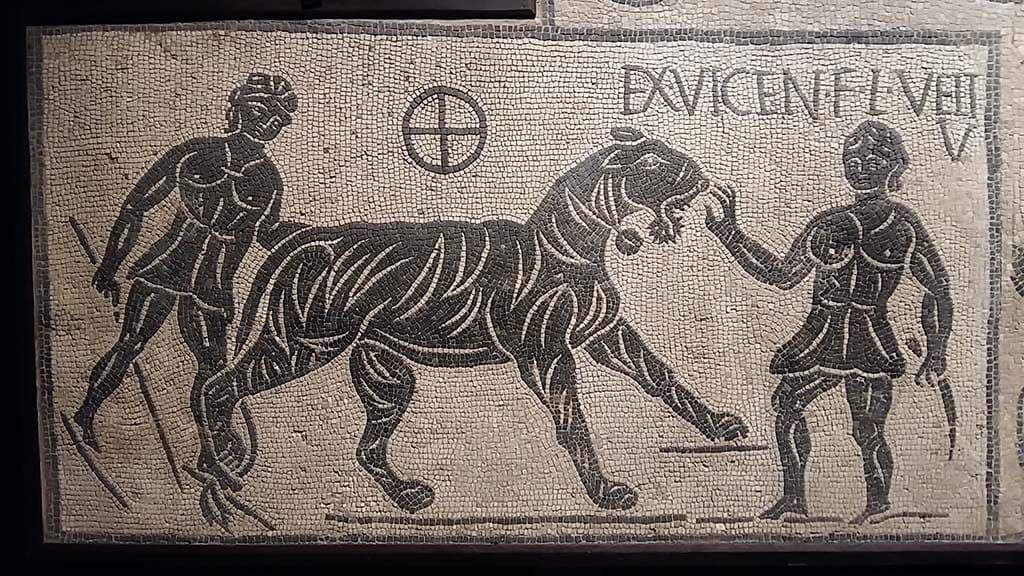
The Global Economics of Tiger Captivity
Tiger captivity is not a marginal enterprise. It is a global industry worth billions, structured like any other business empire. Across the world, more than 40 regional and national zoo associations exist, with roughly 25 under the umbrella of the World Association of Zoos and Aquariums (WAZA). Together, they represent thousands of facilities, employing hundreds of thousands of staff and pulling in over 700 million paying visitors annually. The economic footprint of tiger captivity is immense — and that is precisely why it persists.
Cities compete fiercely to build “flagship” zoos, often using taxpayer money. Politicians promote them as civic pride and tourist magnets. Corporate sponsors attach their brands to tiger exhibits because they guarantee crowds. For every tiger on display, there are ticket sales, souvenirs, café meals, birthday parties, and special “close encounter” packages. One cub can generate millions in revenue over its short commercial lifespan.
This financial power gives tiger captivity political protection. Licenses are renewed without scrutiny, expansions approved without debate. Officials turn a blind eye because zoos fill city coffers and provide local jobs. The economics create inertia: even as conservation science makes clear that real habitats, patrols, and tiger corridors desperately need funding, the money flows into concrete enclosures instead.
The irony is devastating. The annual budgets of the world’s zoos dwarf the combined funding of global tiger conservation in the wild. If redirected, those billions could double the protection of remaining tiger landscapes. Instead, tiger captivity ensures that cages stay full, while wild forests grow emptier.
Tigers as Universal Moneymakers in Tiger Captivity
Nowhere is the logic of profit clearer than in tiger captivity. Across every continent, tigers are the crown jewels of zoos. They are the posters on billboards, the star attractions of marketing campaigns, the reason visitors flock through turnstiles. Tigers are universal moneymakers. And the real jackpot comes in small packages — cubs.
Cubs are the golden eggs of tiger captivity. Their births are carefully publicized, complete with staged photos of keepers bottle-feeding them or children marveling at their tiny paws. Local media rush to report “good news,” while zoos enjoy spikes in ticket sales. White cubs are worth even more, their rarity turned into branding gold. But behind the headlines is a cycle as cold as any factory line. Cubs are often separated from their mothers within weeks, so they can be handled, bottle-fed, and displayed. They are paraded as “ambassadors,” used for selfies, and sold as cuddly symbols of conservation.
By the time these cubs grow too large to cuddle — sometimes as early as six months — they lose their commercial appeal. Adults are expensive to feed, harder to house, and far less profitable. Many are traded between zoos, quietly sold, or simply euthanized in less transparent corners of the world.
This system is not accidental. Tiger captivity is organized around professional breeding programs designed to ensure supply. Zoos trade animals internationally, catalog bloodlines, and justify the process with the same two words: conservation and education. In reality, tigers are commodities — bred, consumed, discarded, and replaced in an endless loop of exploitation. Not unlike tiger trafficking networks that operate in the shadows, except here the trade is perfectly legal.
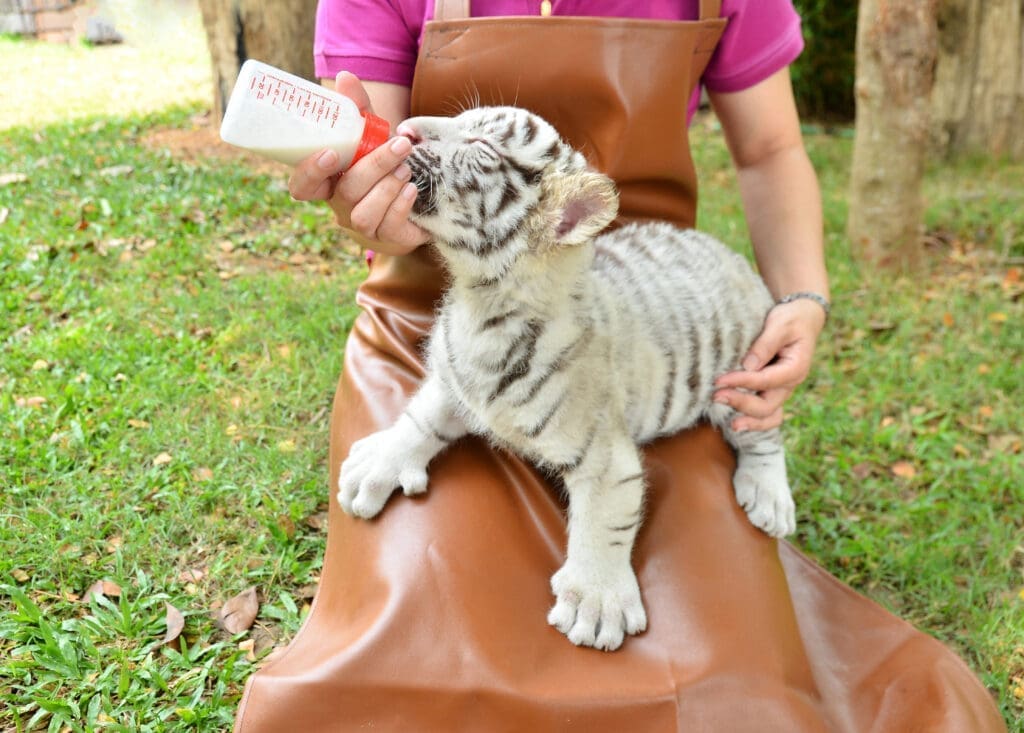
The Breeding Lie: “Saving the Species” in Tiger Captivity
One of the strongest justifications used by zoos is the claim that tiger captivity “saves the species.” The argument is simple: if wild populations are falling, breeding tigers in captivity ensures their survival. On paper, it sounds convincing. In reality, it is a carefully polished lie.
Captive-bred tigers are almost never released into the wild. Their genetics are often mixed across subspecies — Bengal, Amur, Indochinese — producing hybrids with no place in natural ecosystems. Even when they are pure-bred, generations of confinement strip them of vital survival skills. Tigers raised in cages lose their ability to hunt, to navigate large territories, even their instinct to avoid humans. What emerges is not a wild tiger, but an animal designed for captivity — a display piece, not a survivor.
The case of white tigers exposes the lie most brutally. White cubs are not a subspecies but the product of deliberate inbreeding, pairing siblings or close relatives to reproduce a rare recessive gene. The results are horrifying: scoliosis, cleft palates, crossed eyes, clubfoot, even neurological damage. These animals are branded as conservation miracles while they are in fact genetic cripples, manufactured into symbols for marketing campaigns.
Yet tiger captivity continues this practice, celebrating each birth with fanfare. What zoos call “saving the species” is in fact diluting, deforming, and degrading it. It is not preservation. It is corruption — a counterfeit conservation that siphons money away from real conservation practices that could secure wild populations.

Tiger Farming and Global Exploitation
Tiger captivity does not stop at zoos. In many parts of the world, it has metastasized into an even darker business: tiger farming. These facilities operate under the thin disguise of “zoos” or “sanctuaries,” but their real function is industrial-scale breeding for profit. China leads this market. Two of its largest tiger farms each hold more than 1,200 animals, bred year after year. Cubs are displayed for tourists, while adults vanish into the shadows of illegal trade — their skins turned into rugs, their bones boiled into wine, their parts smuggled into black markets.
China alone is estimated to hold more than 5,000 tigers in captivity — more than the total wild population of all subspecies combined. The numbers are suspiciously stable; they never change in official reports. Nobody asks how that is possible. The reality is clear: tiger farms act as laundering machines, funneling animal parts into networks that blend legality and illegality. The world knows it, but China blocks investigators and silences journalists.
The problem spreads further. Laos, Vietnam, and South Africa also host tiger farms, many of them feeding directly into the same trafficking web. In South Africa, breeders market cubs for petting tourism before selling adults into the bone trade. In the United States, hundreds of roadside zoos breed cubs for profit, creating a surplus of discarded adults. Tiger captivity has become global, linking tourist attractions, criminal syndicates, and weak regulators in one seamless chain.
Behind every enclosure lies a pipeline that stretches from cages to markets, sustained by greed and political failure. Tiger farming proves that captivity is not conservation — it is commerce, and its currency is suffering.
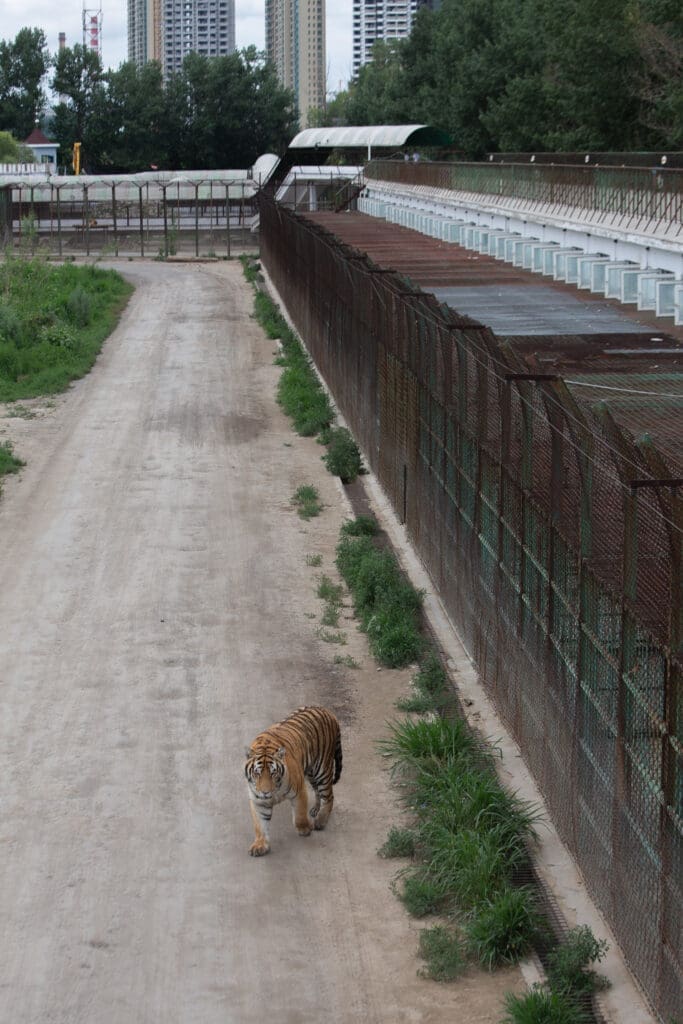
The Psychological Hell of Tiger Captivity
Even when tigers are not beaten or starved, tiger captivity itself is cruelty. These are apex predators designed to roam vast landscapes — females up to 400 square kilometers, males more than 1,000. In zoos and farms, they are reduced to enclosures barely a fraction of that size, often just a few hundred square meters. The confinement crushes them.
The psychological consequences are devastating. Zoochosis, the mental breakdown caused by captivity, is common. Tigers pace obsessively along the edges of their enclosures, sometimes tracing the same line thousands of times a day. They lick, gnaw, or overgroom themselves until their fur falls out. Some slam their heads against bars, a desperate attempt to escape monotony. Others chew their own tails. These repetitive, self-destructive behaviors are not “quirks” — they are open wounds, the visible scars of tiger captivity.
Cubs endure trauma from the very start. Many are separated from their mothers within days, bottle-fed for display, and denied the basic bond that shapes natural development. This early rupture builds lifelong dependency on humans and strips them of survival instincts. By the time they grow into adults, they are unfit for the wild, dependent yet unwanted.
Adults too large to be handled lose their commercial value. Many are quietly transferred, neglected, or euthanized. The industry hides this cruelty behind enrichment toys, feeding shows, and PR-friendly narratives of “care.” But tiger captivity remains what it always has been: psychological torture disguised as compassion. The pacing tiger is not entertainment. It is a prisoner screaming without sound.
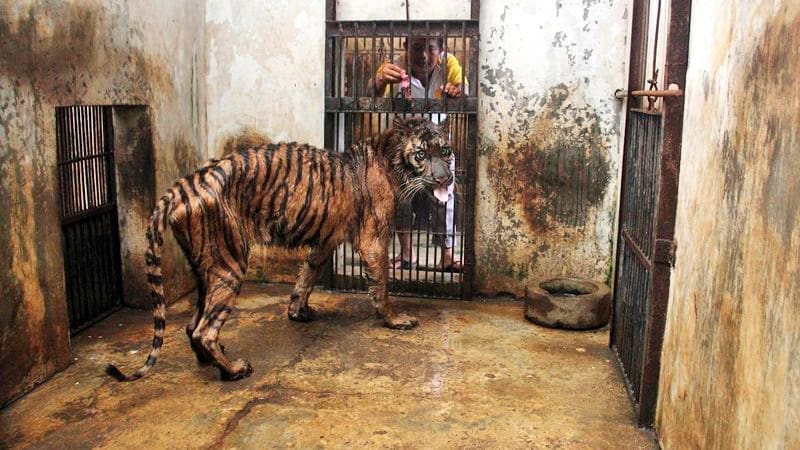
Zoos as Conservation Theaters of Tiger Captivity
Tiger captivity is carefully staged as conservation. Walk into any major zoo, and you’ll see words like “preserve,” “educate,” and “protect” plastered across banners. Keepers talk about breeding programs and awareness campaigns. Politicians cut ribbons at new enclosures, praising them as investments in biodiversity. But in reality, zoos are conservation theaters. The animals are props, the cages are stages, and the script is written for human audiences, not for wildlife.
The scale of the illusion is staggering. Worldwide, zoos hold between 10,000 and 15,000 tigers, including more than 5,000 Amur tigers in China alone. Yet fewer than 5,000 remain in the wild. If captivity really worked as conservation, the wild should be safer by now. Instead, resources are drained into concrete while wild habitats shrink. Some cultures even believe conservation means “putting something in a box to save it for later.” Zoos exploit that mindset, selling captivity as safety while forests vanish and poachers thrive.
The Education Myth of Tiger Captivity
Zoos also defend tiger captivity with the claim of education. But what do children really learn? They see tigers pacing behind glass, not hunting prey or patrolling territories. They learn animals exist for display, not for ecosystems. Real education comes from documentaries, field studies, or live-streaming reserves — experiences that reveal complexity, not cages.
Meanwhile, genuine solutions — anti-poaching patrols, community engagement, and habitat corridors — are underfunded. Zoos may inspire pity, but pity does not protect forests. Captivity comforts audiences. Conservation demands sacrifice.
Alternatives to Tiger Captivity
If tiger captivity is obsolete, what should replace it? The truth is: alternatives already exist. Sanctuaries and rescue centers around the world provide lifetime care for tigers without breeding them for profit. These facilities focus on welfare, not ticket sales. Animals are given space, dignity, and protection — not forced into endless cycles of reproduction and display. Unlike zoos, sanctuaries close their gates to new cubs unless they are rescues. Their aim is not to entertain humans, but to heal animals.
Technology also offers powerful alternatives. Virtual zoos, like GAIA’s “Zoo of the Future” in Belgium, use immersive VR and AR to let visitors experience tigers up close without cruelty. In a single exhibition hall, people can stand “face to face” with a tiger in its natural jungle, not behind bars. Such projects prove that education and awe can exist without exploitation.
Another model is “zoos in the wild.” In these systems, vast protected habitats allow tigers to roam freely while cameras stream their lives in real time. Audiences anywhere in the world can watch cubs play, adults patrol, or hunts unfold — without disturbing or imprisoning them. These digital windows make tiger captivity unnecessary.
Education no longer requires cages. Inspiration doesn’t need concrete. Real encounters can come through documentaries, live-streaming reserves, and virtual experiences. The only thing missing is the willingness of governments and institutions to shift investments away from outdated zoos and into innovative, cruelty-free models. The proof is clear: tiger captivity is not conservation. Alternatives already exist, and they are more powerful, ethical, and sustainable.

Why Tiger Captivity Persists
If tiger captivity is so flawed, why does it survive? The answer is twofold: culture and economics. For centuries, humans have normalized the sight of animals behind bars. Generations of children grew up believing that zoos are benevolent, even educational. Parents still take their kids to see tigers pacing in concrete enclosures, often without questioning what lessons are really being learned. Culture has conditioned us to see captivity as natural, even compassionate. That inertia is powerful.
But the real engine is economics. Tiger captivity is a billion-dollar industry that employs tens of thousands of people and attracts millions of paying visitors each year. Local governments defend zoos not out of ecological conviction, but because they generate revenue, tourism, and votes. Politicians cut ribbons at new “state-of-the-art” enclosures, even while wild habitats crumble. A large number of zoo associations lobby aggressively, ensuring regulations stay friendly. The result is a self-reinforcing cycle: tiger captivity justifies itself with conservation rhetoric, wins public approval, gains political protection, and continues to exploit animals.
This persistence has little to do with science. Conservation biologists have shown again and again that wild protection — corridors, patrols, behavioral change — is far more effective than breeding animals in cages. Yet funding is directed to concrete because concrete is visible, profitable, and marketable. Real conservation is messy and politically inconvenient.
Tiger captivity survives not because it is necessary, but because it is profitable. It is a relic of ego and greed, dressed up in modern branding. The longer society tolerates it, the further we drift from genuine solutions.
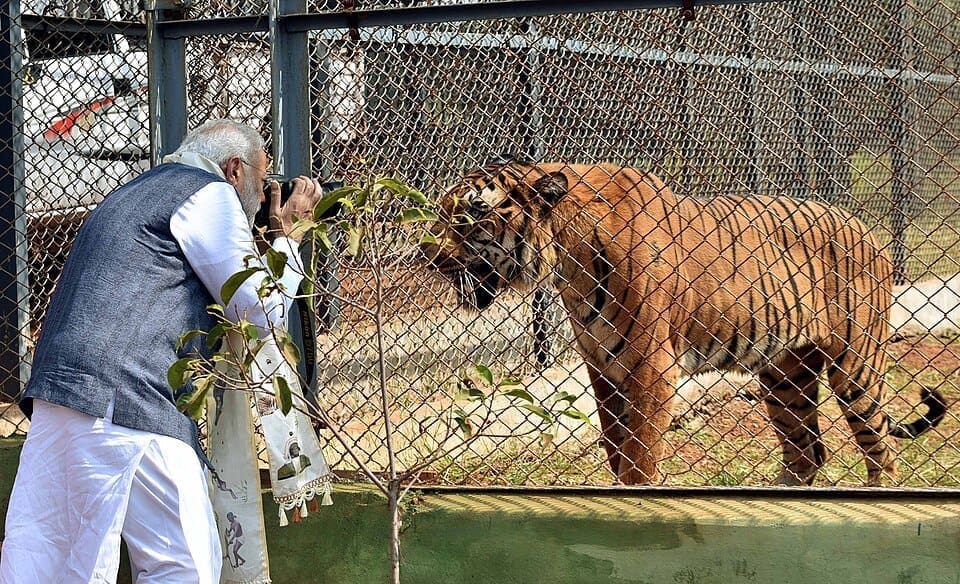
The Verdict: Tiger Captivity Has No Place in Modern Society
The evidence is overwhelming. Tiger captivity is not conservation. It is exploitation disguised as science. Tigers are bred for profit, paraded as mascots, and discarded when they lose their commercial value. Captive breeding produces hybrids, genetic deformities, and psychological collapse. Far from “saving the species,” tiger captivity dilutes and degrades it.
Meanwhile, the billions poured into cages drain the resources needed for true protection. Patrols go underfunded, corridors remain unprotected, and communities living alongside wild tigers struggle for support. The result is a grotesque inversion: more tigers live in cages than in the wild. Zoos celebrate this imbalance as success. In truth, it is failure.
From Roman arenas to today’s industrial farms, tiger captivity has always been about human vanity. It reveals more about our hunger for control and profit than our care for nature. In the 21st century — an age defined by extinction crises — this model is indefensible. Every dollar spent on enclosures could secure habitats, train rangers, or fight poaching. Every cub bred for display is another reminder of misplaced priorities.
The verdict is simple: tiger captivity has no place in modern society. The future of tigers lies in forests, not cages. Our choice is clear. End the cycle of exploitation. Support sanctuaries, not breeding farms. Fund corridors, not concrete. Push governments to stop licensing cruelty under the name of conservation. Zoos had centuries to prove their worth. They failed. If we are serious about saving tigers, we must abandon captivity and fight for their survival in the only place they belong — the wild.
